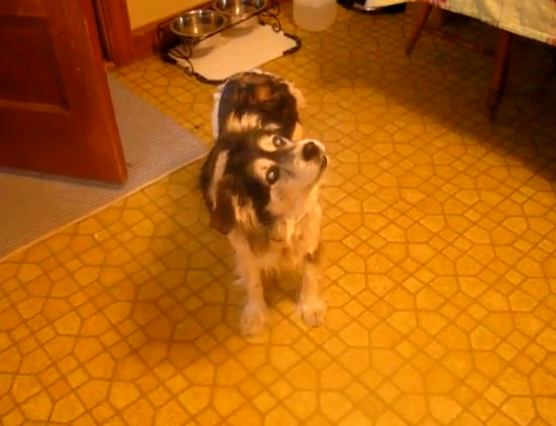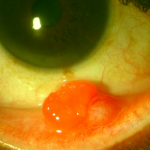Old dog vestibular disease is a condition which affects dogs and is characterized by an abnormal walk like a drunken sailor along with a tilted head.
When one observes a dog frequently tilting its head, then it is a sign that the affected dog is feeling imbalanced. Medically, the head tilt is described as tilting of the head away from its positioning with the limbs and trunk, to either side of the dog’s body. The affected dog may also look like trying to avoid falling, or fighting to maintain a balanced posture.
One of the most common causes of head tilting in dogs are conditions which affect the vestibular system. It is a sensory system that is situated in the inner ear, and which carries information that is vital to retain an upright body posture as well as to move around with confidence. In common terms, the vestibular system informs the body about its place in relation to the ground, i.e., whether the body is upside down, upright, still, moving, etc.
Tilting of the head may also be present in old dogs from time to time. It may not necessarily require any medical treatment. It is however a best practice to check instances of old dog vestibular disease in your pet, so as to identify the presence of severe underlying disorders.
Symptoms of old dog vestibular disease
The signs and symptoms of old dog vestibular disease are listed below:
- A head tilt to either side of the body
- Anomalous posture of the head
- Nausea, sudden bouts of vomiting
- Lack of proper coordination, stumbling
- Abnormal or erratic movements of the eyes, noticeable incapability to focus
- Loss of balance, an unsteady gait, or continuously falling over
- Running around in circles
Causes of old dog vestibular disease
The underlying causes of old dog vestibular disease is current unknown. However, the below listed factors may increase the risk to development of the disorder:
- Diseases of the brain
- Injuries of the ear
- Metabolic conditions
- Deficiency in nutrition, such as thiamine deficiency
- Neoplasia, which refers to irregular growth of tissue
- Toxicity, for instance use of harmful antibiotics in the dog’s ear
- Inflammation of the inner and central ear canal caused by parasitic, bacterial, or other kinds of infections.
- Infection of the upper respiratory tract

Diagnosis
- The vet will conduct a thorough standard physical exam, which includes a CBC, an electrolyte panel, a blood chemical profile, and a urinalysis to diagnose old dog vestibular disease. The pet owner also requires to give complete information about the dogs’ medical history till the time the symptoms were first observed.
- In most cases, the blood tests results are normal. However, in case of infections or the presence of certain underlying disorders, the blood test results may have some changes. Infections, thyroid disorders and other pre-existing systemic diseases may require further tests.
- The vet will completely inspect the ear canal to verify the presence of ear infection. A sample of the substances occurring within the ear is also taken for additional testing.
- X-rays, visual diagnostic tools, MRI or magnetic resonance imaging, and CT or computed tomography may be needed to ascertain disease of the middle ear.
- The vet may also conduct a bone biopsy to verify involvement of bones due to infection or tumor.
- Old dog vestibular disease caused due to infection or inflammation of the brain can be diagnosed via CSF or cerebrospinal fluid analysis. It may be noted that CSF is a watery and clear liquid which protects and surrounds the spinal cord and the brain.
- The vet will also check for any nutritional deficiencies. The pet owner will require to provide information about the normal diet of the dog, along with extra foods or supplements given to the dog. For instance, excessive intake of fish and raw meats can lead to thiamine deficits, resulting in old dog vestibular disease.

Treatment of old dog vestibular disease
- Dogs that are severely affected by old dog vestibular disease may require hospitalization and supportive care. Frequent vomiting can lead to loss of fluids from the body. It can be treated with fluid replacement therapy.
- Most dogs suffering from old dog vestibular disease do not require any special diets, unless the condition is caused by deficits in nutrition. For instance, thiamine supplements may be given to dogs experience head tilting due to thiamine deficiency.
- Ear infections can be treated with broad-spectrum prescription antibiotics which can eliminate the infections of middle ear and the brain.
- Surgery may be required to treat certain cases of old dog vestibular disease.
Prognosis of old dog vestibular disease varies as per the underlying causative disease. Tilting of the head caused due to ear infections have a high percentage of complete recovery. Pet owners must take their dogs for regular checkups. They should also ensure that all medications are given on time, and all treatment guides are strictly adhered to.
Recovery Time
This purely depends on the age of the dog and the degree of affliction. The dog can also learn to overcome this disease. The factors that can hasten the recovery time of old dog vestibular disease is the rest given and a good well-lit environment. Do not carry the dog because if it moves or walks, it may feel disoriented. If you do have to lift the dog, hold it by the pads of its feed while they are lifted off the ground. Ensure that the dog’s eyes are fixed on the horizon, so that the balance is maintained.
The Old Dog Vestibular Disease recovery time may be anywhere between 1 and 5 months. The symptoms can disappear in young dogs but may be more of a permanent nature in older ones.


When you adopt a dog, it becomes part of the family. Dogs also
guard tangibles and intangibles from one another. Rather, using a firm tone of voice
and rewarding it with treats has a more positive effect overall.
you need proof readers-I doubt recovery depends on the age of the doctor. 😉
Thanks! Edited.
Our dog is blind and he appears to have Vestibular Disease. Thought he was having a seizure so took him to vet. He appeared healthy take him home and observe. Took him back when he kept tipping over, thinking seizure. They took bloodwork, we took him home. Eye twitching began, imbalance began but not to the point of tipping over. Vet called said that bloodwork showed slightly elevated Kidney enzynes….think it is something in his brain. I asked well what about Vestibular? And because he didn’t show extreme signs of this she said she didn’t think so. Now 2 days later he is sooooo Vestibular!! He looks like some of the dogs in the video’s. Cant even stand, completely tips over and we have to hand feed him. The first symptoms began almost 4 days ago, today is the worse he has been. We think we should consult a different vet while we wait this out in the hope of it being idiopathic????
Hi, just read about your dog. Realize it was two years ago but my dog is showing same signs and want to know what you did. Not sure what to do or if my dog will get over it or worse?
thanks!
If you do have to lift the dog, hold it by the pads of its feed while they are lifted off the ground.
should be; pads of its feet.